Raising your garden bed doesn’t have to feel like lifting weights at the gym! Choose a sunny spot and use lightweight materials like cedar or metal to keep it chic and breezy. You can even build raised beds 12 to 24 inches high for easy access – goodbye back strain! Incorporate a drip irrigation system to save time while watering. With these simple tips, you’ll be well on your way to a flourishing garden oasis! Ready to dig deeper?
Choosing the Right Location for Your Garden Bed
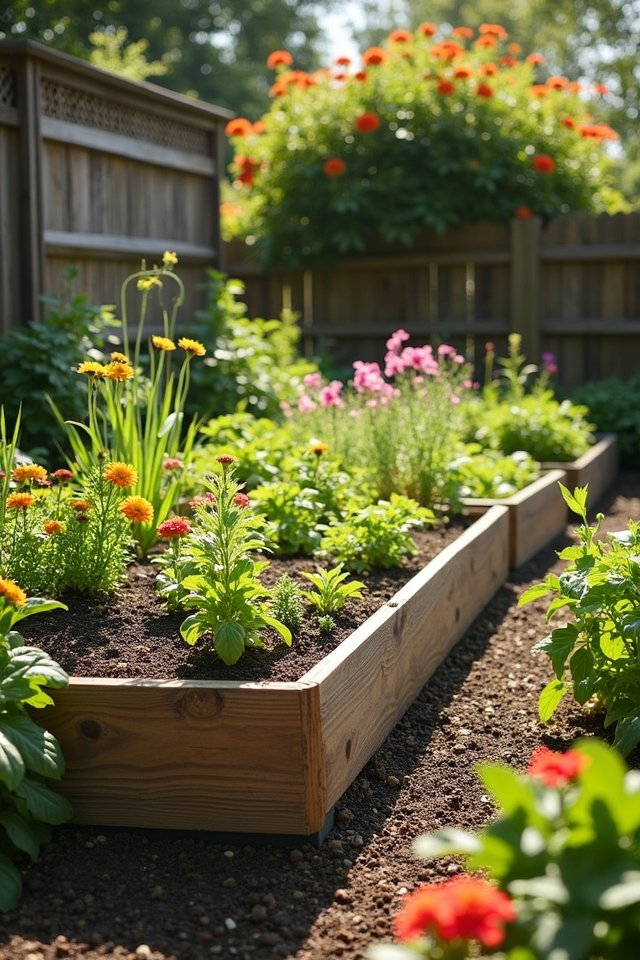
Have you ever wondered why some gardens flourish while others seem to just give up? It all comes down to choosing the right location! First, think about sunlight exposure. Most veggies crave about six hours of sun daily, like sunbathers at a beach! Now, onto drainage considerations—nobody wants soggy roots. Pick a spot where water runs off, like a sloped hillside. If you’ve got a flat area, consider adding some pebbles or a raised bed to help with this. And remember, don’t place your garden near big trees; they’re like the free riders of the garden world, stealing water and nutrients! By choosing wisely, you’re setting up your plants for the ultimate success party! Ready to dig in?
Selecting Materials for Your Raised Bed
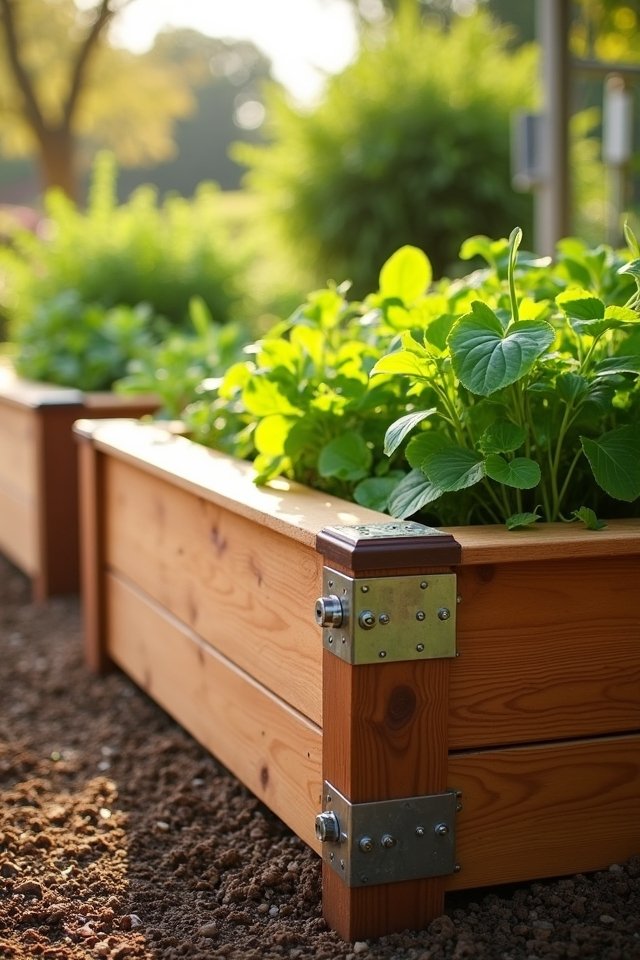
When you plunge into selecting materials for your raised bed, it’s like finding the perfect building blocks for your garden masterpiece! Think about diverse wood types—cedar’s natural resistance to decay could be your best friend, while pressure-treated pine offers affordability. What’s not to love? Metal options, like galvanized steel, present a sleek, modern look and durability that could outlast the competition. Picture your garden bed glistening in the sunlight, elevating your plants with style. Just imagine the compliments from neighbors! Whatever materials you choose, make sure they’re safe for your plants and won’t leach harmful chemicals. So, are you ready to let your creativity bloom? Each choice adds personality, turning your garden into a vibrant expression of you!
Determining the Size and Height of Your Garden Bed
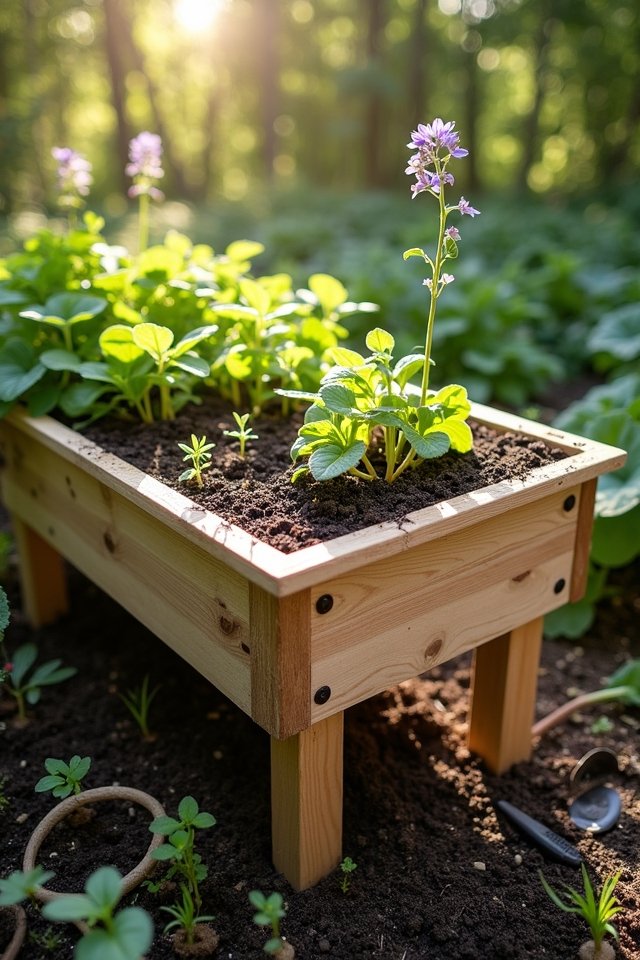
Now that you’ve picked out materials that sing to your gardening spirit, it’s time to think about the size and height of your raised bed. Imagine your veggies thriving in a space just right for them! When deciding on bed dimensions, consider your gardening goals and available space.
- Small beds (4×4 feet) are perfect for novices!
- Medium beds (4×8 feet) offer versatility for herbs and flowers.
- Tall beds (2-3 feet high) save your back while planting.
- Wider beds (4 feet across) let you reach everything!
- Narrow, long beds fit snugly in smaller spots.
Height considerations can make a big difference, so think about your comfort level. Ready, set, grow!
Preparing the Ground for Easy Installation
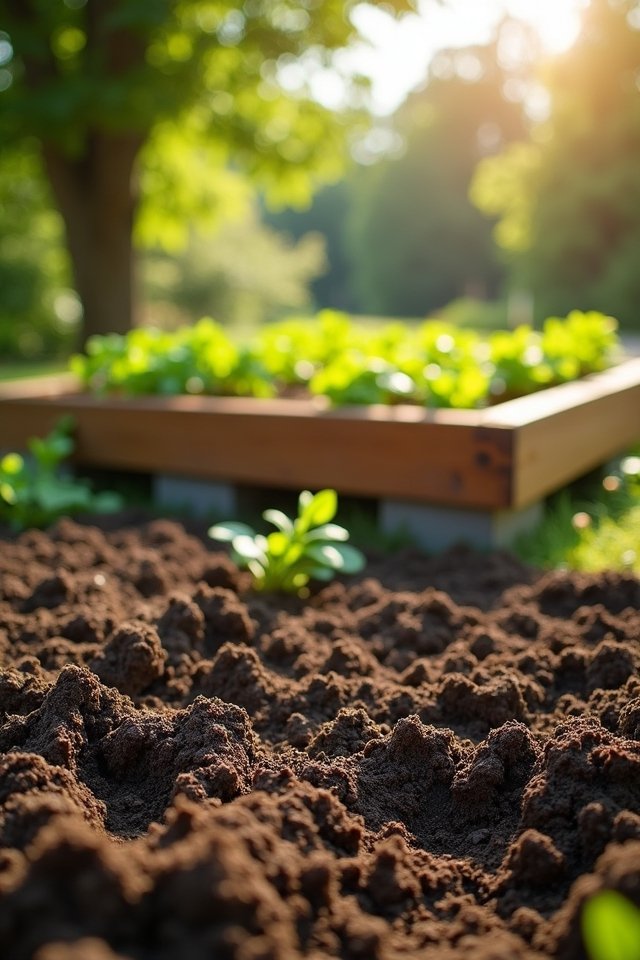
Before you reveal your garden bed masterpiece, it’s essential to roll up your sleeves and prepare the ground beneath! Start with a thorough soil assessment to discover what’s hiding beneath that crunchy surface. Is it compacted clay, sandy loam, or something else? You’ll want to know that for successful planting! Next, focus on ground elevation. Leveling the area not only helps with drainage but also makes your bed look polished and professional. Grab a shovel and dig, creating a smooth and even base as if you’re laying a foundation for a garden castle! Trust me, spending a little time on this now will save you plenty of headaches later. Plus, the satisfaction of digging in is bliss—don’t you agree?
Assembling the Garden Bed Without Heavy Lifting
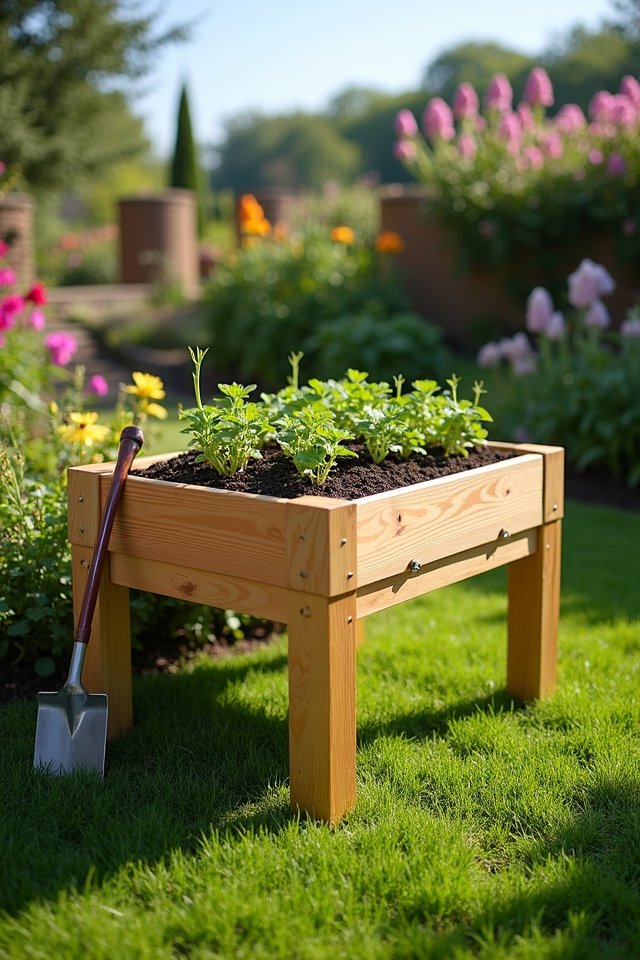
Imagine transforming your backyard into a vibrant haven filled with fresh veggies and blooming flowers, all without needing to channel your inner weightlifter! With easy assembly using lightweight materials, you’ll have your garden bed set up in no time, leaving you more energy for watering—and of course, admiring your hard work!
- Opt for interlocking boards for quick setup.
- Use pre-cut panels to save time and effort.
- Choose composite materials that resist rotting.
- Consider modular options that fit any space.
- Harness tools that make assembly a breeze!
Feel the excitement as you watch your vibrant garden take shape! This innovative approach not only simplifies assembly but also makes gardening accessible for everyone—no heavy lifting required!
Adding Soil and Compost for Optimal Growth
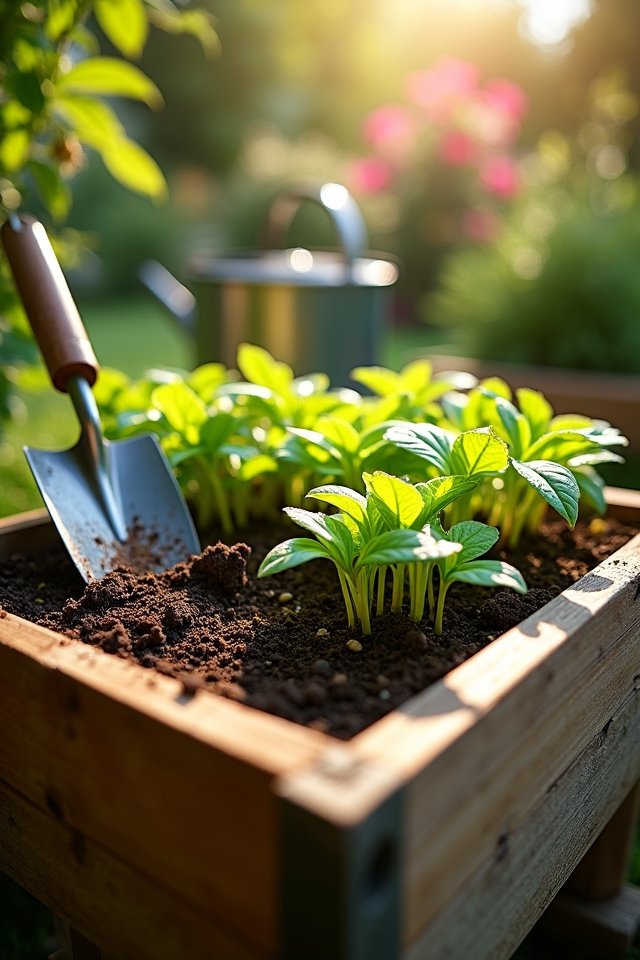
As you immerse yourself in nurturing your new garden bed, one essential step can make all the difference: adding the perfect soil and compost! Imagine the rich, earthy aroma as you blend different soil types like loamy gold or gritty sandy delights. Mixing in compost, with its nutrient-packed benefits, keeps your plants dancing with joy! Picture your veggies thriving, their roots reaching into that sweet, crumbly mix. You’ll find speeds of growth you never thought possible! Just think about how your nearby neighbors will marvel as your tomatoes outshine theirs. So grab that wheelbarrow, feel the thrill, and create a vibrant habitat where your plants can flourish, thanks to the magical potion of soil and compost combined! Isn’t nature grand?
Incorporating Efficient Watering Systems

While your plants are basking in the glorious sunshine, they’re also thirsty for the right amount of water! Keeping your garden hydrated doesn’t have to be a chore. Imagine effortlessly nourishing your plants with innovative watering systems like drip irrigation and soaker hoses! They’re game-changers, making sure every drop counts.
- Drip irrigation delivers water directly to the roots, like a gentle rain on a parched land.
- Soaker hoses weep water deeply, ensuring your plants quench their thirst fast.
- Timers help you schedule watering, taking the guesswork out of hydration!
- Mulching retains moisture, reducing watering frequency.
- Rain barrels recycle nature’s bounty, serving your garden while saving on your water bill.
Planting Strategies for Successful Growth

After your garden’s been quenched and revitalized, it’s time to think about what you’re actually planting. You’ve got choices! Consider companion planting—it’s like matchmaking for plants! Marry tomatoes with basil, and they’ll thrive together, warding off pests while amplifying flavors. Next, accept crop rotation; switch things up each season. Just like you wouldn’t eat the same cookie every day, your soil deserves variety too! Try growing carrots one season, then follow up with leafy greens. This keeps your soil nutrients balanced and happy! By mixing plant allies and revitalizing your soil, you’ll cultivate a vibrant, fruitful garden, bursting with energy! Excited to dig in? Trust me, your future dishes will thank you! Happy planting!
Maintaining Your Raised Garden Bed With Minimal Effort

Maintaining your raised garden bed can feel like a breeze when you’ve got a few tricks up your sleeve! With the right approach, you can keep things thriving with minimal effort. Here are five nifty tips:
- Mulch regularly to conserve moisture and suppress pesky weeds.
- Use companion planting to naturally deter pests; marigolds are great for keeping those annoying aphids at bay!
- Water deeply but infrequently to encourage deep root growth—like sending your plants on a quest for the treasure!
- Rotate your crops each season to prevent soil depletion and pest build-up.
- Stay vigilant with an occasional check; early detection of problems is key!
Harvesting Tips for a Bountiful Yield

When the time comes to harvest your bounty, the excitement can be almost overwhelming! Picture plump tomatoes bursting with flavor or crisp lettuce ready for a revitalizing salad. To maximize your yield, consider implementing crop rotation; it’s like giving your soil a spa day! This simple shift helps keep pests at bay and nutrients flowing.
Also, don’t underestimate the power of companion planting. Imagine kale cozied up next to carrots, enhancing each other’s growth like best friends! When you harvest, pick in the early morning when flavors are most vibrant. And remember, a little nudge goes a long way—gently twist or cut to avoid damaging your plants. So, gear up, grab those shears, and make it a joyful treasure hunt!
Frequently Asked Questions
Can I Use Recycled Materials for a Raised Garden Bed?
You can use recycled materials like old wood and metal containers for your raised garden bed! Think of weathered wood, full of character, creating a rustic charm. Or imagine vibrant metal containers adding a splash of color to your space. It’s eco-friendly and budget-friendly! Just make sure the materials are safe for plants. So, release your creativity, and transform those forgotten items into a stunning garden oasis! Isn’t gardening fun?
How Do I Prevent Pests in My Raised Garden Bed?
Preventing pests in your raised garden bed feels like a culinary adventure! Imagine your plants dancing in harmony with their companions. By using companion planting, you create a natural fortress. For example, plant marigolds alongside your tomatoes; these bright beauties naturally repel nasty pests. Plus, you can sprinkle natural repellents like crushed garlic or chili powder around your bed—who knew that a little spice could spice up your garden, too? Happy gardening!
What Plants Are Best for Shallow Raised Garden Beds?
When choosing plants for shallow raised garden beds, think about the ones with shallow roots. Herbs like basil and cilantro love container gardening— they’re perfect for your setup! You’ll also want to contemplate radishes; they sprout quickly and bring a crisp crunch to your meals. Can’t forget about baby greens; they add vibrant color and freshness! With these choices, you’ll create a little edible paradise right at your fingertips! How exciting!
How Often Should I Check the Soil Moisture?
You should check your soil moisture regularly, ideally every few days! Just imagine your plants sipping water; they’ll thrive if you stay on top of it. You can use moisture meters for quick, accurate readings—they’re like little magical wands for your garden! If the meter shows dry, it’s time to water! Staying attentive guarantees your leafy friends don’t end up parched like a desert cactus. Keep them happy, and they’ll reward you with blooms!
Is It Necessary to Use a Weed Barrier?
Did you know that a single weed barrier can cut your garden’s weed growth by up to 90%? Using landscape fabric isn’t just a luxury; it’s a game-changer! Think of it as a cozy blanket for your soil, keeping pesky weeds at bay while allowing water and nutrients to flow through. It’s like having a garden buddy that works tirelessly, so you can focus on those beautiful blooms instead of battling weeds! Why not give it a try?


